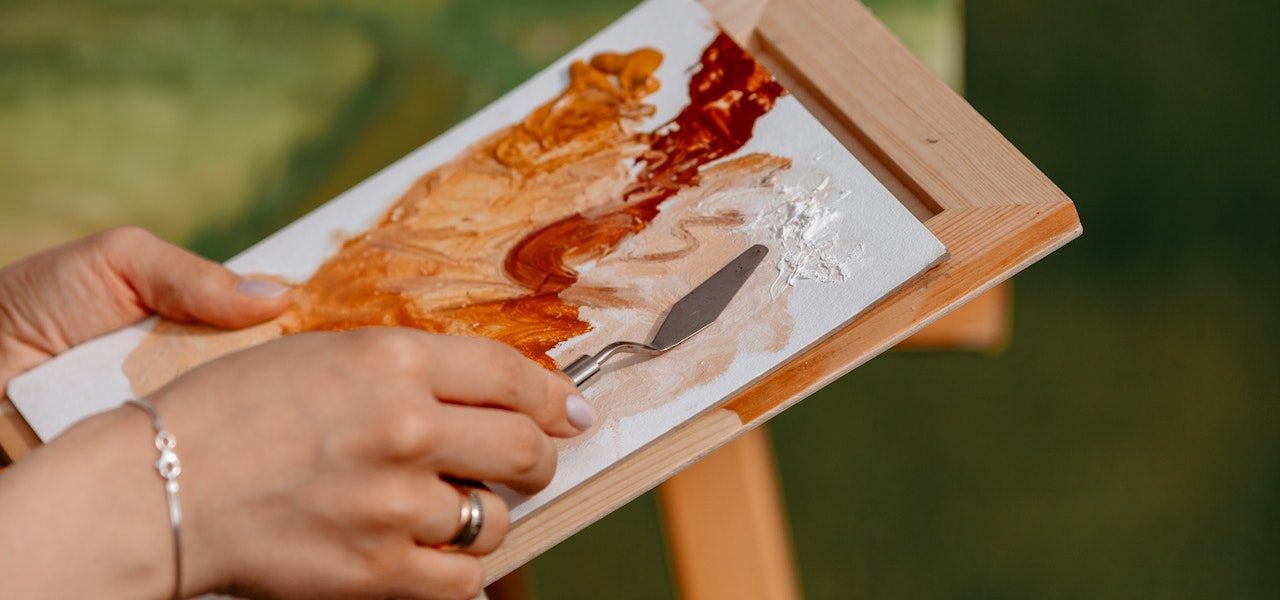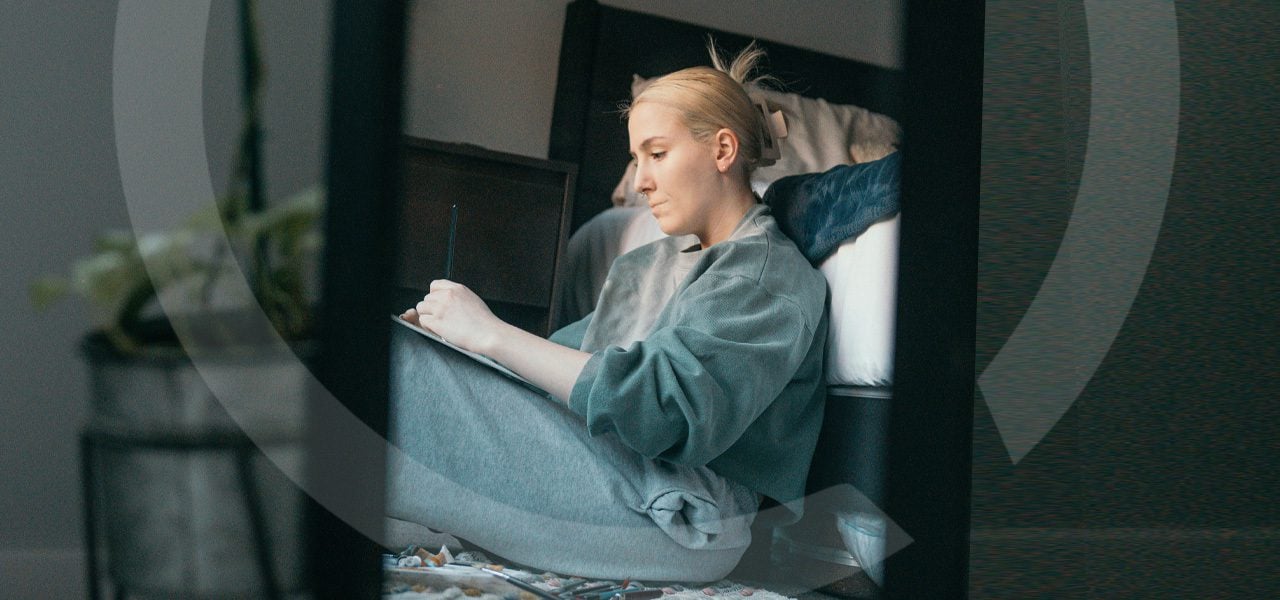It is a cold, west coast late afternoon. The sun is just going down for the day outside the windows of the little rancher that Carolyn Simpson uses as her art studio these days in Nanaimo, B.C.
She is quietly, calmly, purposefully taking yet another inquirer into her realm. A place where one can expect to find all the tools of her trade – brushes, pottery, palettes. But hers is also a studio where one learns about monsters and tricksters, allies, and heroes. Especially heroes.
Simpson, 50, is a woman committed to the concept of using art as therapy. She has nearly two decades of doing so. With a bachelor’s degree in Psychology, and a graduate diploma the Vancouver Art Therapy Institute. Along her path to Nanaimo, she spent several years as a dental hygienist, helping create whiter healthier smiles, but missing her calling.
It is in this studio, a small one-time 70’s style home purchased on the roadside of the EHN Edgewood Nanaimo campus, that she listens to that voice inside her, and those living inside the patients she meets on daily basis.
Simpson is one of several clinicians across the Edgewood Health Network Canada, a collection of in and outpatient buildings and offices spanning the nation from the Annapolis Valley in Nova Scotia to the east coast of Vancouver Island. She has been part of the fabric of the staff at Edgewood since 2021, trying to help people suffering from all sorts of trauma, addictive behaviors, and substance misuse issues. Like any artist, she has her own style, her own way of doing things. Like any EHN Canada clinician, she is qualified, dedicated to science and spirit, and has her sleeves rolled up, ready to battle the monsters that live within so many of her patients.
Monsters that tell them they are not okay. That they are not worthy. That everything is their own fault. That they cannot get happy or live at peace. In other words, the lies that live deep within, judging, sabotaging, tricking them.
Her battles alongside clients aren’t fought with weapons, of course. Today, she and her patients may be wielding a paint brush. Tomorrow, a pair of gloves and eye shields. The day after, maybe a glue gun. No matter, the goal is the same. Give her people a voice.
“A lot of times people just assume that art therapy is good for the folks that are non-verbal. Or children. But for addictions there are so many things; the judgement, the shame, so many things that we push down, that are buried. They can be very difficult to access, especially through verbal means. Cognitive Therapy is wonderful. But at the same time, it does have its limitations, just like everything,” she says.
“You know the iceberg model of what we see is what we see, and underneath of that is what we don’t see? Well, sometimes it is not even available to our own conscious, to our own self. What the art does, in a way, is enable us to access these things, and often it is preverbal.”
In other words, there are things, ideas, beliefs, about us and others that unless we are willing to take the journey within, we may never know exist. Why we do the things we do, think the way we think.
And when you come to Edgewood, whether there for substance use issues or trauma or both, you have agreed to start that journey. And one of the allies you will meet is this soft-spoken sage from Montreal, who first found her own artsy side refurnishing furniture.
“Oh yeah, I’m creative,” she says, clearly more comfortable talking about what she does over who she is or how she got there. “I’ve always had that sort of creative impulse that I knew that just sort of held that space to be in that – it was like meditation for me. I knew that there was power in it. I just didn’t know that there was actually a career for it.”
Over the course of a two-month (average stay), Edgewood patients get to experience a series of one-on-one and group activities with Simpson. Up to 95 percent of them haven’t done any sort of artwork since 12 or 13, she says.
“And that is a pretty interesting time where it is often, we are told what are you doing that for? That judgement comes in. We are told why you are wasting your time; you’re not going to do anything with it,” she says.
And the chance to express is lost, right then and there for too many.
That delicate adolescent phase is also where many children discover substances and risky behaviours that often lead to stunted or jagged emotional growth, locking in shame and guilt and other negative self-beliefs. Recovery itself asks humans to go deep into themselves to find out where their emotions and feelings were frozen or knocked around. Art therapy is one way of doing that.
Somewhere around their third week in treatment, Simpson will see a patient, either one on one or in a group setting. They are already emersed into the treatment process. The audience, in a sense, is captive – they are in treatment after all. They may or may not be thrilled about that fact, but they are on their paths.
She usually starts a session with a guided meditation. There may be some breath work. Sessions often end with a poem. In her studio she will hold space for the hour or so that she gets with her patients. It is there they begin to learn more about things they may not see, as they approach their creative side.
Simpson is well versed in the teachings of Joseph Campbell, the great American writer and professor. His Hero with a Thousand Faces, published in 1949, opened a pandoras box of never ending and profound theories about the journey of the archetypal heroes found in countless mythologies. Campbell’s phrase, “Follow your bliss,” is one many rely on as a guide to self-fulfillment and inner peace. George Lucas credited Campbell’s theories as the genesis of the iconic Star Wars franchise. It is all about the path, the journey inside, which dovetails with the notion of recovery. The university of you. Why are you here?
“I talk a lot about the idea, this archetype, the hero, the call. Do you pay attention to that call? Most people don’t. It takes a few times. And sometimes it takes a crisis. A whole lot of times it takes a crisis. You find yourself walking through those doors and entering this idea of what it is, from the known world to the unknown world. You may have been in recovery before, but each time is a brand-new time. You go in that underworld, and I’m pretty sure there are going to be some beasts and monsters. Pretty sure there are going to be riddles to solve.”
As patients reveal their inner voices through creative expression, art therapy is clearly not about drawing stickmen. It is not about idle time.
Patients may build a walking stick, the metaphor of support at the forefront of conversation. They may do a collage, picking photos or pieces which represent phases of their lives, a bunch over here, a glaring one over there, all combining into a gloriously complicated reflection of who they really are. They may select a foundation for a face and create a mask – a disguise most people in recovery are familiar with. What is behind the paint, the scars, designs, the colors?
“We do a lot of mask making here, and what comes up? The trickster, the intellectualizer. We can smoke and mirror all we want, but when we bring it outside of ourselves there is an opportunity to just be that witness in this moment. The past, well that has been cement. We talk a lot about that, and how much time we spend back there, and how much time we spend on the road ahead where the possibilities are, like, this wide, but they are focussing on this.”
A glimpse into the inner self, where those monsters and tricksters pin us down.
“So many folks here feel so powerless, the shame and guilt is so heavy. So, we can shift things for them, whether it is a healing stick to see what support they do have in their lives, or another project, to witness it in a different way.”
“Across Edgewood, we pay attention to what we need to move in the body. We pay attention, hopefully, and this is why we have different avenues of creative expression. If you want to grab some clay and pound it, we have got that. If you want to throw some paint at the wall, because at that point your life it is just a mess, we might do that. What happens more often than not, folks will throw paint and then actually get their hands in it and start moving it around. It is very tactile, very much about making that mark in this mess.”
Expressive. Creative. Art.
“I often think of that analogy of the iceberg. What we see is what we see. This is the behavior; this is what is known. Then there is what we don’t see. Sometimes we know what we are pushing down. We know. But often the things that are hidden from others are also hidden from our own conscious mind. I often find working in that, it feels like we are working in a different space, in that spiritual realm. Like we have access to something that is beyond our own, whether we have pushed it down or, just because. In those experiences, maybe those things did happen preverbal, and we didn’t have language to attach to it.”
With over 18 years of experience, including working with youth and adults in the Development and Disabilities department for the Fraser Health Authority prior to coming to Edgewood, Simpson will be the first one to say that she wishes she could spend more time with the clients. But the FHA is fully funded by the BC Government to the tune of $2.95 billion annually, while Edgewood is mostly, privately funded, so these teachers and in turn the students, take what they can get.
One of the projects Simpson has become fond of is the Broken Bowl. Based on the philosophies of wabi-sabi ideas of acceptance of transience and imperfection, a bowl is smashed and put back together by the patient.
“So many times, people come into Edgewood and say I am broken. I am cracked. So, the idea is to bring these pieces back together in golden joinery (known as Kintsukuroi). They put it back together and they see these things that broke them. Then we talk about how they are still here. What brought you here? So, we begin changing the narrative.”
Sometimes the shifts in patients during a session are immediate, other times the ah-ha moment comes hours, days or even weeks later. Good communication between counselors in and out of the studio is a big part of therapy. Knowing where someone is on their treatment path, what they respond to, can improve outcomes.
When they leave treatment, people enter recovery and hear all sorts of valuable cliches and slogans. One Day at a Time. Recovery is a journey, not a destination. Don’t leave before the miracle happens. Many of them relate to the journey of healing, a time of immense change.
“You know, society doesn’t offer a lot of places for that place of movement, that shift, that rite and practice of transitioning,” says Simpson. “I see Edgewood as this place of transition. Hopefully. That potential to shift. And just being able to offer that, in a way, that makes sense to me.”
One famous Chinese proverb claims the journey of a thousand miles begins with a single step. There are plenty of parallels in the realm of recovery, and in art therapy, that tell you to get into the much and do your journey, follow your bliss.
“Folks say yeah that’s the journey,” says Simpson. But don’t forget to tell people that there are also allies willing to come down with the light to help you come through. The idea is coming back up the hero, and you have now a road map. It is not going to be anybody else’s road map, but it is your map. If you are able to bring that map, if you are able to share with the community, you transition from that hero, the hero of your own life, hero of your own journey, into the sage. Into the wise one. So, integrated trauma becomes wisdom.”
Given the vast number of structured lectures, groups, assignments, and counseling activities on the agenda for Edgewood patients, the combination is a secret sauce which works just fine, if you go by the thousands of people who are on the Edgewood alumni mailing list.
Carolyn Simpson and her art therapy sessions are a prime example of the Edgewood Health Network is an allie, doing all it can to help families, friends and fellow travelers reclaim its heroes.



